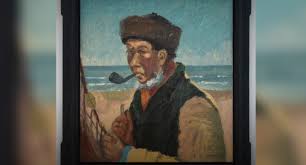|
Getting your Trinity Audio player ready...
|
A $50 Garage Sale Find Turns Out to Be a $15M Original Van Gogh: A Tale of Discovery and Intrigue
Edited by; TJVNews.com
In a story that reads like a treasure hunt from a Hollywood script, a painting bought for a mere $50 at a garage sale in Minnesota could very well be an undiscovered masterpiece by Vincent van Gogh. The painting, which depicted a fisherman named “Elimar” standing next to a net, was purchased by a man who thought he was merely getting an inexpensive piece of artwork. Little did he know, this dusty old canvas would set off a chain of events leading to a potential $15 million discovery. The revelation that the painting might be the work of one of the most iconic artists in history has captivated the art world and raised intriguing questions about how works of this magnitude can slip through the cracks of history.
As The Wall Street Journal recently reported, the saga began when Maxwell Anderson, a former curator at the Metropolitan Museum of Art, was among the first to take a deep interest in the painting. Anderson’s expertise in art history quickly led him to believe the piece could be the real deal. Upon viewing the painting, Anderson was immediately struck by the distinctive style that resembled van Gogh’s approach to painting, particularly his tendency to reinterpret the works of other artists. Anderson remarked, “I was struck by what I saw. The analysis conducted on this distinctive painting provides fresh insight into the oeuvre of van Gogh, particularly as it relates to his practice of reinterpreting works by other artists. This moving likeness embodies van Gogh’s recurring theme of redemption, a concept frequently discussed in his letters and art.”
Anderson’s initial interest grew as he assembled a team of 20 art experts, including conservators, scientists, and historians, to verify the painting’s authenticity. Their months of intensive analysis led them to a remarkable conclusion: the painting, which had been bought for a fraction of its value at a random garage sale, was likely an original Vincent van Gogh. According to ArtNews.com, the painting was appraised at $15 million, far exceeding the $50 price tag it had been sold for.
The process of verifying the painting’s authenticity was meticulous, as Anderson and his team used every tool at their disposal. The team’s findings were compiled into an exhaustive 458-page report. Among their discoveries was the realization that the fisherman’s smile in the painting had a distinctively van Gogh-esque quality, something that resonated with the artist’s signature style. In addition, traces of red pigment were found within the layers of the paint, believed to be a reference to van Gogh’s own red hair, a detail that further supported the claim of authenticity.
One of the most compelling pieces of evidence was the canvas itself, which had a thread count matching those used during van Gogh’s time, as well as pigments consistent with those used by the artist. This careful attention to historical detail strongly suggested that the painting was created during a time when van Gogh’s style was evolving. The team also speculated that the painting might have been created in 1889, the same year “The Starry Night” was completed, a period of intense emotional and artistic growth for the artist.
These findings seemed to all but confirm that the painting was an original van Gogh, but there was one more hurdle: official verification. As The Wall Street Journal report noted, the Van Gogh Museum in Amsterdam, the primary authority on the artist’s works, has yet to make a final, official determination regarding the painting’s authenticity. While the team of experts and conservators believes in the painting’s legitimacy, the museum’s confirmation will be the final step in bringing this sensational discovery into the fold of art history.
Regardless of whether the painting is officially authenticated, the mere discovery of a possible van Gogh in a Minnesota garage sale is nothing short of remarkable. This story shines a proverbial spotlight on the sheer unpredictability and magic of the art world, where valuable works can sometimes be hidden in plain sight, misjudged or overlooked for years. The fact that an unsuspecting individual was able to purchase this potential masterpiece for such a modest price only adds to the intrigue and excitement surrounding the discovery.
This potential find also raises questions about the way art history is written and how masterpieces can remain hidden for long periods, despite being in plain view. The ability for such an extraordinary painting to go unnoticed and unappreciated until now serves as a reminder of how many potential works of historical significance are still lying undetected in private collections or tucked away in storage.
Vincent van Gogh, despite his tragic and short life, has become one of the most celebrated artists in history. His works, ranging from portraits and self-portraits to landscapes and still lifes, have made an indelible mark on the world of art. Known for his bold use of color, expressive brushwork, and emotional depth, van Gogh’s works have reached record-breaking auction prices, with some of his paintings selling for tens of millions of dollars.
If “Elimar” is indeed an authentic van Gogh, it will add another piece to the puzzle of his artistic evolution. This discovery would offer new insights into van Gogh’s creative process, particularly his reinterpretation of subjects and his ongoing search for spiritual meaning, themes that appear in many of his works.
The possible reintroduction of this piece into the world of van Gogh’s catalog could not only shine a new light on his artistic evolution but also reignite public interest in his lesser-known works. Such an event also serves as a reminder of the power of art to surprise, enchant, and inspire, as even the most casual encounters—like a garage sale in Minnesota—can hold the key to rediscovering lost masterpieces.




